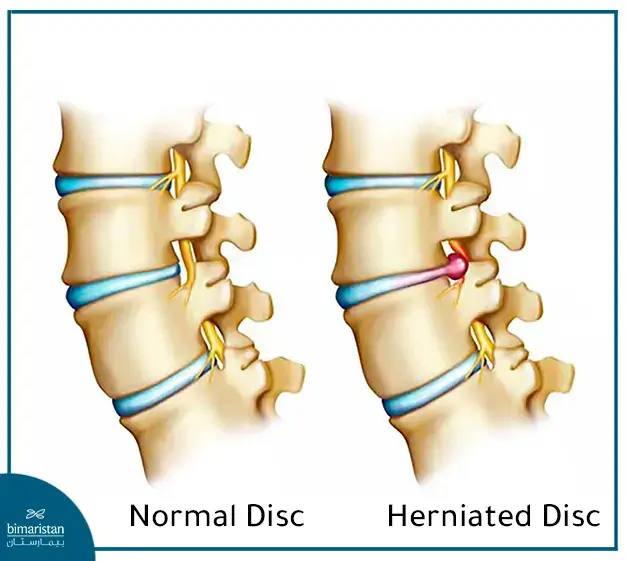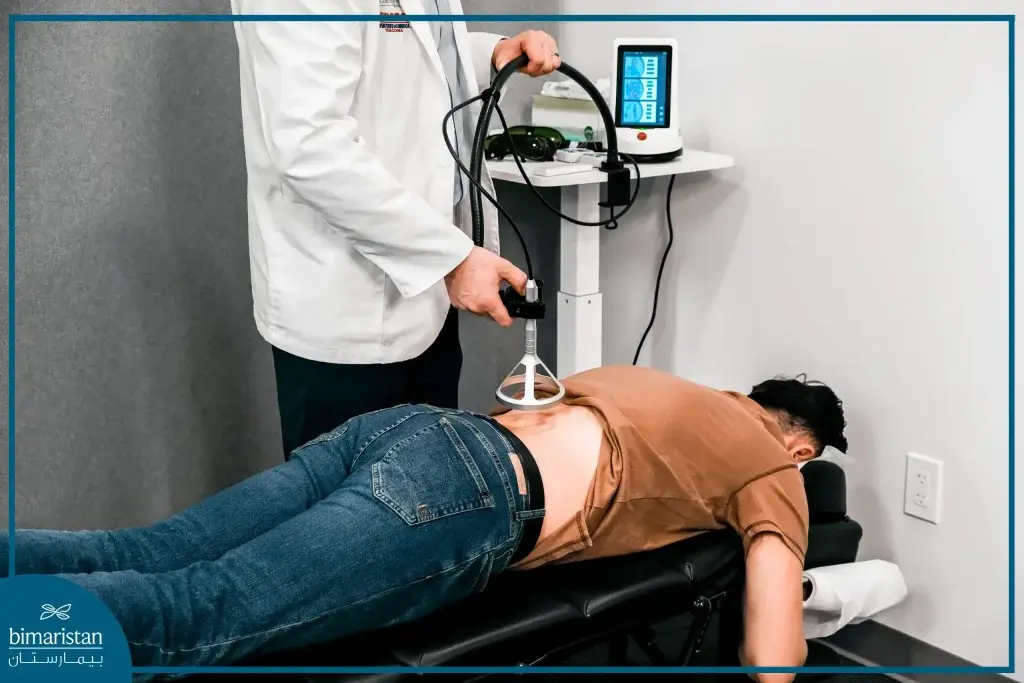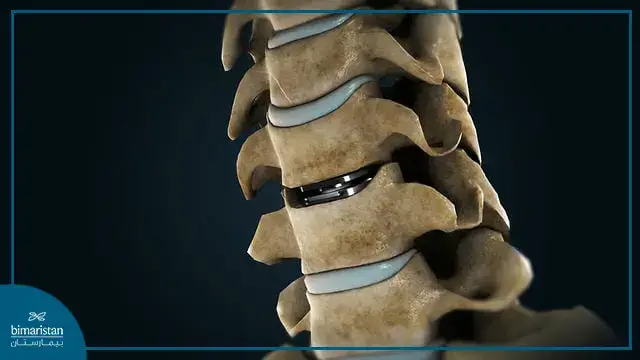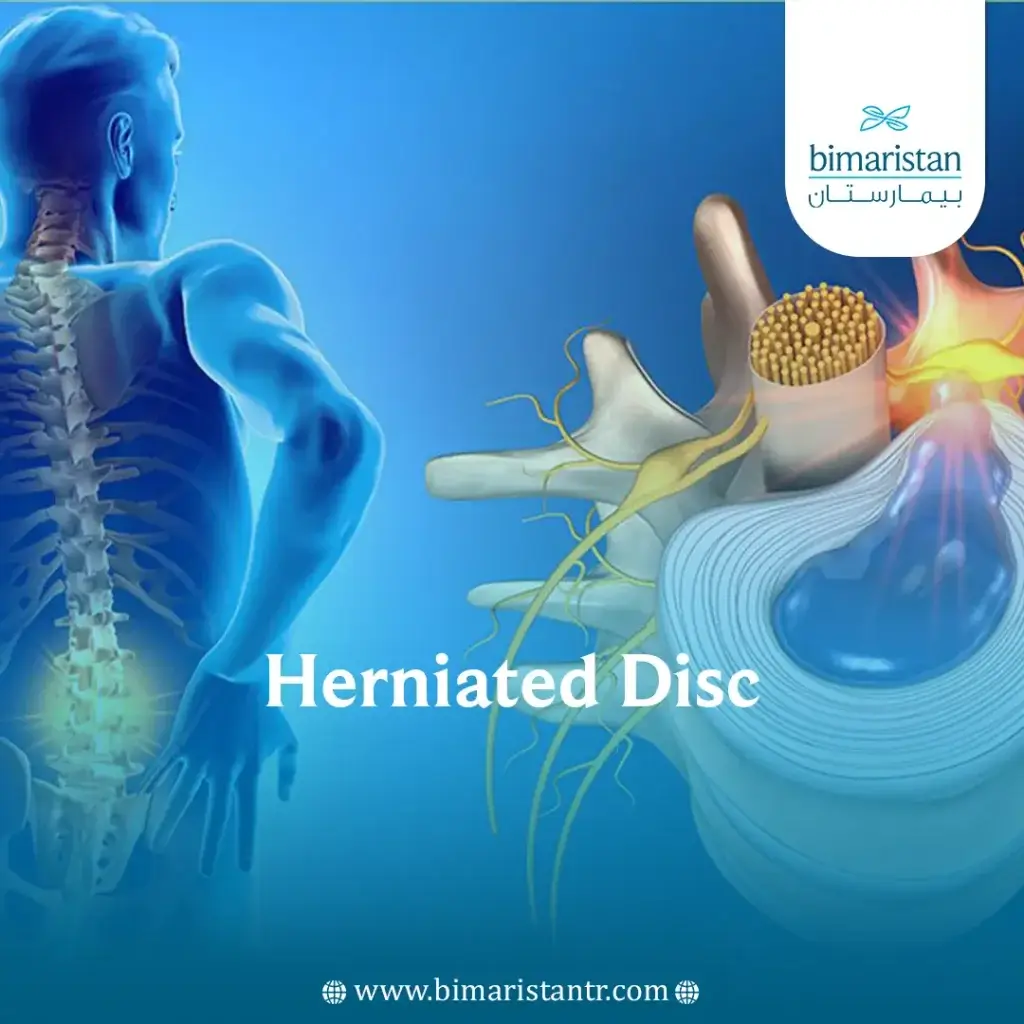Herniated disc operation is one of the most common spine surgeries performed in Turkey. It has a high success rate, with studies indicating that 80% to 90% of patients notice a significant improvement in symptoms after surgery.
The average age of patients who undergo herniated disc surgery ranges between 30 and 50 years, although this surgery can be performed on individuals of all ages.
Surgery for a herniated disc on the lumbar (lower) spine is considered the most common, especially at the level of the fourth and fifth lumbar vertebrae L4-L5 and the fifth lumbar and first sacral vertebrae L5-S1. Surgery on the cervical spine is followed in terms of popularity by surgery on the lumbar spine.
What is a herniated disc?
Before talking about herniated disc surgery, we must talk about how a herniated disc occurs.
The vertebrae in the spine are separated by discs made of cartilage tissue. These discs help with movement and connect the vertebrae. Each disc has two parts: the inner pulp, called the nucleus pulposus, and an outer fibrous ring. As we age or due to injuries, the outer fibrous ring can weaken. If it tears, the inner pulp can push out through the damaged outer ring, putting pressure on the nerves. This is known as a herniated disc or disc herniation.

Most herniated discs occur in the lower back, but they can also occur in the neck. Symptoms depend on where the disc is located and whether the disc is pressing on a nerve. A herniated disc often affects one side of the body. Symptoms include:
- Pain in the arm or leg
- Numbness or tingling on the affected side of the body
If the herniated disc is in the lower back, it usually presents with pain in the lower back, buttocks, thigh, and leg, and the pain may be felt in the leg.
A herniated disc in the neck, also known as a neck disc, typically causes pain in the shoulder and arm. This pain may radiate to the arm or leg when you cough, sneeze, or move into specific positions. The pain is often described as sharp or burning.
It is possible for an individual to have a herniated disc without showing symptoms, which may be discovered incidentally during a spine X-ray.
Disc Herniation Types
The purpose of herniated disc surgery is to relieve pressure on the nerve, thus relieving pain and other symptoms.
About 60% to 90% of individuals with a herniated disc recover without surgery using nonsurgical treatments such as NSAIDs, epidural steroid injections (disc prophylaxis), laser disc therapy, and physical therapy.

As for patients who are refractory to non-surgical treatment, one of the following types of herniated disc surgery can be used to relieve pressure on the nerve:
- Discectomy
- Endoscopic disc operation
- Surgery on the core of the spinal disc
- Laminectomy
- Spinal fusion process
- Artificial disc surgery
Discectomy
It is a surgery to remove part or all of a herniated disc in the spine. This procedure is especially performed for herniated discs that do not respond to surgical treatment.
Your doctor will recommend a discectomy if you have a herniated disc and the following symptoms:
- Severe pain or numbness in the leg or arm that does not improve, making it difficult to do daily tasks.
- Severe weakness in the muscles of the arm, lower leg, or buttocks.
- Pain spreading to the buttocks or legs (sciatica).
- Cauda equina syndrome (sudden weakness or numbness and problems controlling the bladder and bowels). These conditions require surgery for a herniated disc to begin immediately.
Types of discectomy
There are different types of discectomies depending on the patient’s health status and the location of the herniated disc:
Open discectomy
The surgeon creates a large incision in the skin and moves the back muscles aside to access and work .on the disc directly
Minimally invasive discectomy (MIS)
The surgeon starts by making a small incision in the skin and then uses a series of progressively larger tubes, called dilators, to create a tunnel through the muscle. Special instruments, including an endoscope, are used to help the surgeon see and operate in a smaller space. Similar procedures to this surgery include minimally invasive microdiscectomy and arthroscopic disc surgery.
Anterior cervical discectomy and fusion (ACDF)
This surgery is for the neck (cervical spine). The surgeon approaches the damaged disc from the front of the neck. They then remove the disc and perform a spinal fusion by placing bone grafts or implants in the space where the disc originally was. This helps provide stability and strength to the patient’s neck.
Depending on the patient’s condition, the surgeon may remove part or all of the damaged disc. In addition, one (single-level) or more (multi-level) disks can be removed.
Arthroscopic disc surgery
It is a straightforward surgical procedure that effectively alleviates chronic lower back and leg pain. This advanced disc surgery utilizes a high-definition camera attached to an endoscope, which is inserted through a ¼-inch skin incision to the specific location in the spine that is causing the pain. By performing arthroscopic disc surgery, spine surgeons can operate safely and with greater precision, leading to better outcomes for patients.
The surgeon can observe the spine on a high-resolution monitor and work through the endoscope using highly specialized precision instruments such as a laser, radiofrequency probe, or surgical graspers.
The difference between minimally invasive discectomy and arthroscopic disc surgery
Minimally invasive discectomy encompasses a broad range of surgical techniques and is considered a standard in spine surgery. Arthroscopic disc surgery is equally significant to the preceding procedure.
Arthroscopic disc surgery distinguishes itself by significantly reducing injury to the patient’s muscles and soft tissues, leading to faster recovery. This procedure uses a surgical method that avoids the main stabilizing muscles in the lower back.
The incision for minimally invasive surgery is one inch or more, while for arthroscopic disc surgery, it is ¼ inches. Smaller incisions and avoiding major back muscles can greatly improve patient outcomes.
Unlike minimally invasive surgery, the arthroscopic disc operation is performed faster and does not require general anesthesia. This provides patients with fewer risks and a faster discharge from the hospital within 2-3 hours of surgery.
Surgery on the core of the spinal disc
The surgeon utilizes instruments to access the core of the disc and then employs a vacuum to extract it, thereby reducing pressure on the nerve.
It is important to know that surgery can only be performed if the fibrous outer layer of the disc is not damaged.
Laminectomy
The lamina is part of the vertebrae that covers and protects the spinal canal. Sometimes, doctors need a laminotomy (removal of part of the lamina) or laminectomy (removal of the entire lamina) to repair a herniated disc.
Both procedures involve making a small incision down the middle of the back or neck over the area of the slipped disc. After removing part or all of the lamina, the surgeon performs a discectomy to remove the slipped disc.
A laminectomy can be:
- Surgery in the lumbar region: It helps relieve leg pain or sciatic pain caused by a herniated disc in the lower back area
- Surgery in the cervical region: It helps relieve neck and upper extremity pain caused by a herniated disc in the neck area
Spinal fusion
Spinal fusion is a procedure to stabilize the vertebrae. It is often performed after a laminectomy. Spinal fusion may be necessary to stabilize the spine.
Spinal fusion involves attaching two bones together using screws. People who undergo spinal fusion may experience pain and feel as if the treatment is restricting certain movements.
The likelihood of needing this operation depends on the location of the slipped disc. Typically, lumbar laminotomy procedures require spinal fusion.
Cervical laminotomy requires spinal fusion if the surgeon is working on the front of the neck. This operation rarely requires the same procedures as if the surgeon were working on the back of the neck. The point from which the surgeon operates depends on the exact location of the herniated disc.
Some people who have had a laminectomy may be candidates for artificial disc surgery instead of spinal fusion.
Artificial disc replacement
It is an alternative to spinal fusion. In this surgical procedure, the surgeon replaces the damaged disc with an artificial disc.
Artificial disc surgery is usually associated with less pain and less restricted movement compared to spinal fusion.

Artificial disc design
Some disc replacement devices include the nucleus (central) of the intervertebral disc but leave the annulus (outer ring) in place.
In most cases, artificial disc replacements replace both the ring and nucleus with a mechanical device that mimics the function of the spine.
There are several different disc designs. Each is unique in its own way, but all share a similar goal: to mimic the size and basic function of a natural intervertebral disc.
Some discs are made of metal, others are a combination of metal and plastic, similar to knee and hip joint replacements. Materials used include medical plastic (polyethylene), medical cobalt chromium, or titanium alloy.
If you visit Bimaristan Medical Center, your surgeon will discuss with you the best disc design for your needs.
Preparation before herniated disc operation
Herniated disc surgery is similar in the way it is prepared, as the surgeon must do the following for the patient:
- Conduct a comprehensive physical examination
- Order imaging tests such as X-rays, myelography, or MRI.
- View your complete medical history
- Know the medications or nutritional supplements you are taking and whether they are contraindicated or not.
- Making changes to some medications, such as removing or adding certain medications.
- Knowing the patient’s history of smoking and if the nicotine in tobacco could interfere with healing time, the surgeon will likely ask you to stop smoking at least four weeks before surgery.
Risks of slipped disc operation
slipped disc operation rarely results in complications, however, some people may experience :
- bleeding
- Inflammations
- Tears in the protective lining of the spine
- Allergic reactions to anesthesia
- Cerebrospinal fluid (CSF) leak
- Spinal nerve injury
- In about 5% of people, the problem disc may rupture again, causing symptoms to reoccur.
Surgery for a slipped disc can be an effective treatment for many people with difficult pain. However, surgeons cannot guarantee that symptoms will disappear after surgery.
Slip disc operation cost in Turkey
The cost of a slipped disc operation varies depending on the type of surgical procedure, the patient’s condition, and the appropriate surgical procedure for him.
For non-surgical procedures such as lasers and injections, the price is about 2,500 US dollars.
The cost of arthroscopic disc surgery and minimally invasive microscopic disc surgery ranges between 2500 and 3000 US dollars per disc (i.e., for one herniated disc) if spinal fusion (vertebral stabilization) is not needed.
While the cost of the vertebrae stabilization procedure may reach approximately 7-8 thousand US dollars.
The decision to undergo surgery for a herniated disc should be carefully balanced with conservative treatment options, taking into account factors such as the severity of symptoms, the individual’s general health, and his response to non-surgical interventions. This requires a specialized medical team that is aware of the results of the surgical procedure and its complications. Therefore, the Bimaristan Center provides a medical team that includes the most skilled surgeons. In Turkey, so do not hesitate to visit our medical center to discuss the appropriate treatment options for you.
: Sources
- DISC
- MedicalNewsToday
- American Association of Neurologic Surgeons

